Thermal Inactivation Mechanism and Structural Features Providing Enhanced Thermal Stability of Hyperthermophilic Thermococcus sibiricus L-Asparaginase in Comparison with Mesophilic and Thermophilic L-Asparaginases
Abstract
1. Introduction
2. Results
2.1. Comparison of L-Asparaginase Sequences
2.2. Determination of L-ASNase Activity
2.3. Thermoinactivation of L-ASNases
2.4. Secondary Structure Changes and Thermodynamic Parameters of L-ASNases during Thermodenaturation Studied by CD Spectrometry
2.5. Changes in the Tertiary Structure of L-ASNases during Thermal Denaturation
3. Discussion
4. Materials and Methods
4.1. Enzymes and Chemicals
4.2. Determination of L-ASNase Catalytic Activity
4.3. Registration and Analysis of CD Spectra
4.4. Registration of Fluorescence Spectra
5. Conclusions
Supplementary Materials
Author Contributions
Funding
Data Availability Statement
Acknowledgments
Conflicts of Interest
References
- Egler, R.A.; Ahuja, S.P.; Matloub, Y. L-asparaginase in the treatment of patients with acute lymphoblastic leukemia. J. Pharmacol. Pharmacother. 2016, 7, 62–71. [Google Scholar] [CrossRef] [PubMed]
- Jia, R.; Wan, X.; Geng, X.; Xue, D.; Xie, Z.; Chen, C. Microbial L-asparaginase for application in acrylamide mitigation from food: Current research status and future perspectives. Microorganisms 2021, 9, 1659. [Google Scholar] [CrossRef] [PubMed]
- Juluri, K.R.; Siu, C.; Cassaday, R.D. Asparaginase in the Treatment of Acute Lymphoblastic Leukemia in Adults: Current Evidence and Place in Therapy. Blood Lymphat. Cancer 2022, 12, 55–79. [Google Scholar] [CrossRef] [PubMed]
- Medawar, C.V.; Mosegui, G.B.G.; Vianna, C.M.d.M.; da Costa, T.M.A. PEG-asparaginase and native Escherichia coli L-asparaginase in acute lymphoblastic leukemia in children and adolescents: A systematic review. Hematol. Transfus. Cell Ther. 2020, 42, 54–61. [Google Scholar] [CrossRef] [PubMed]
- Kotzia, G.A.; Labrou, N.E. Cloning, expression and characterisation of Erwinia carotovora L-asparaginase. J. Biotechnol. 2005, 119, 309–323. [Google Scholar] [CrossRef]
- Zuo, S.; Zhang, T.; Jiang, B.; Mu, W. Reduction of acrylamide level through blanching with treatment by an extremely thermostable l-asparaginase during French fries processing. Extremophiles 2015, 19, 841–851. [Google Scholar] [CrossRef]
- Kornbrust, B.A.; Stringer, M.A.; Lange, N.E.K.; Hendriksen, H.V. Asparaginase—An Enzyme for Acrylamide Reduction in Food Products. In Enzymes in Food Technology, 2nd ed.; Wiley-Blackwell: Hoboken, NJ, USA, 2009; pp. 59–87. ISBN 978-1-444-30993-5. [Google Scholar]
- da Cunha, M.C.; Aguilar, J.G.d.S.; Orrillo Lindo, S.M.D.R.; de Castro, R.J.S.; Sato, H.H. L-asparaginase from Aspergillus oryzae spp.: Effects of production process and biochemical parameters. Prep. Biochem. Biotechnol. 2022, 52, 253–263. [Google Scholar] [CrossRef]
- Hong, S.-J.; Lee, Y.-H.; Khan, A.R.; Ullah, I.; Lee, C.; Park, C.K.; Shin, J.-H. Cloning, expression, and characterization of thermophilic L-asparaginase from Thermococcus kodakarensis KOD1. J. Basic Microbiol. 2014, 54, 500–508. [Google Scholar] [CrossRef]
- Xu, F.; Oruna-Concha, M.J.; Elmore, J.S. The use of asparaginase to reduce acrylamide levels in cooked food. Food Chem. 2016, 210, 163–171. [Google Scholar] [CrossRef]
- Dumina, M.; Zhgun, A.; Pokrovskaya, M.; Aleksandrova, S.; Zhdanov, D.; Sokolov, N.; El’darov, M. Highly active thermophilic l-asparaginase from melioribacter roseus represents a novel large group of type II bacterial L-asparaginases from chlorobi-ignavibacteriae-bacteroidetes clade. Int. J. Mol. Sci. 2021, 22, 13632. [Google Scholar] [CrossRef]
- Dumina, M.; Zhgun, A.; Pokrovskaya, M.; Aleksandrova, S.; Zhdanov, D.; Sokolov, N.; El’darov, M. A Novel L-Asparaginase from Hyperthermophilic Archaeon Thermococcus sibiricus: Heterologous Expression and Characterization for Biotechnology Application. Int. J. Mol. Sci. 2021, 22, 9894. [Google Scholar] [CrossRef] [PubMed]
- Pokrovskaya, M.V.; Pokrovskiy, V.S.; Aleksandrova, S.S.; Anisimova, N.Y.; Andrianov, R.M.; Treschalina, E.M.; Ponomarev, G.V.; Sokolov, N.N. Recombinant intracellular Rhodospirillum rubrum L-asparaginase with low L-glutaminase activity and antiproliferative effect. Biochem. Suppl. Ser. B Biomed. Chem. 2012, 6, 123–131. [Google Scholar] [CrossRef]
- Pokrovskaya, M.V.; Aleksandrova, S.S.; Pokrovsky, V.S.; Veselovsky, A.V.; Grishin, D.V.; Abakumova, O.Y.; Podobed, O.V.; Mishin, A.A.; Zhdanov, D.D.; Sokolov, N.N. Identification of Functional Regions in the Rhodospirillum rubrum l-Asparaginase by Site-Directed Mutagenesis. Mol. Biotechnol. 2015, 57, 251–264. [Google Scholar] [CrossRef]
- Dobryakova, N.V.; Zhdanov, D.D.; Sokolov, N.N.; Aleksandrova, S.S.; Pokrovskaya, M.V.; Kudryashova, E.V. Improvement of Biocatalytic Properties and Cytotoxic Activity of L-Asparaginase from Rhodospirillum rubrum by Conjugation with Chitosan-Based Cationic Polyelectrolytes. Pharmaceuticals 2022, 15, 406. [Google Scholar] [CrossRef]
- Dumina, M.; Zhgun, A. Thermo-L-Asparaginases: From the Role in the Viability of Thermophiles and Hyperthermophiles at High Temperatures to a Molecular Understanding of Their Thermoactivity and Thermostability. Int. J. Mol. Sci. 2023, 24, 2674. [Google Scholar] [CrossRef]
- Simossis, V.A.; Heringa, J. PRALINE: A multiple sequence alignment toolbox that integrates homology-extended and secondary structure information. Nucleic Acids Res. 2005, 33, W289–W294. [Google Scholar] [CrossRef] [PubMed]
- Lubkowski, J.; Wlodawer, A. Structural and biochemical properties of L-asparaginase. FEBS J. 2021, 288, 4183–4209. [Google Scholar] [CrossRef] [PubMed]
- Guo, J.; Coker, A.R.; Wood, S.P.; Cooper, J.B.; Chohan, S.M.; Rashid, N.; Akhtar, M. Structure and function of the thermostable L-asparaginase from Thermococcus kodakarensis. Acta Crystallogr. Sect. D Struct. Biol. 2017, 73, 889–895. [Google Scholar] [CrossRef]
- Zuo, S.; Xue, D.; Zhang, T.; Jiang, B.; Mu, W. Biochemical characterization of an extremely thermostable l-asparaginase from Thermococcus gammatolerans EJ3. J. Mol. Catal. B Enzym. 2014, 109, 122–129. [Google Scholar] [CrossRef]
- Papageorgiou, A.C.; Posypanova, G.A.; Andersson, C.S.; Sokolov, N.N.; Krasotkina, J. Structural and functional insights into Erwinia carotovora L-asparaginase. FEBS J. 2008, 275, 4306–4316. [Google Scholar] [CrossRef]
- Strzelczyk, P.; Zhang, D.; Alexandratos, J.; Piszczek, G.; Wlodawer, A.; Lubkowski, J. The dimeric form of bacterial l-asparaginase YpAI is fully active. FEBS J. 2022, 290, 780–795. [Google Scholar] [CrossRef] [PubMed]
- Micsonai, A.; Wien, F.; Kernya, L.; Lee, Y.H.; Goto, Y.; Réfrégiers, M.; Kardos, J. Accurate secondary structure prediction and fold recognition for circular dichroism spectroscopy. Proc. Natl. Acad. Sci. USA 2015, 112, E3095–E3103. [Google Scholar] [CrossRef]
- Magri, A.; Soler, M.F.; Lopes, A.M.; Cilli, E.M.; Barber, P.S.; Pessoa, A.; Pereira, J.F.B. A critical analysis of L-asparaginase activity quantification methods—Colorimetric methods versus high-performance liquid chromatography. Anal. Bioanal. Chem. 2018, 410, 6985–6990. [Google Scholar] [CrossRef] [PubMed]
- Wriston, J.C. Asparaginase. Methods Enzymol. 1970, 17, 732–742. [Google Scholar]
- Pokrovskaya, M.V.; Pokrovsky, V.S.; Aleksandrova, S.S.; Sokolov, N.N.; Zhdanov, D.D. Molecular Analysis of L-Asparaginases for Clarification of the Mechanism of Action and Optimization of Pharmacological Functions. Pharmaceutics 2022, 14, 599. [Google Scholar] [CrossRef]
- Wojcik, M.; Miłek, J. A new method to determine optimum temperature and activation energies for enzymatic reactions. Bioprocess Biosyst. Eng. 2016, 39, 1319–1323. [Google Scholar] [CrossRef]
- Cornish-Bowden, A. Fundamentals of Enzyme Kinetics; Elsevier: Amsterdam, The Netherlands, 1979. [Google Scholar]
- Pain, R.H. Determining the Fluorescence Spectrum of a Protein. Curr. Protoc. Protein Sci. 2004, 38, 1–20. [Google Scholar] [CrossRef]
- Gao, Y.S.; Su, J.T.; Yan, Y. Bin Sequential events in the irreversible thermal denaturation of human brain-type creatine kinase by spectroscopic methods. Int. J. Mol. Sci. 2010, 11, 2584–2596. [Google Scholar] [CrossRef]
- Szilágyi, A.; Závodszky, P. Structural differences between mesophilic, moderately thermophilic and extremely thermophilic protein subunits: Results of a comprehensive survey. Structure 2000, 8, 493–504. [Google Scholar] [CrossRef]
- Ahmed, Z.; Zulfiqar, H.; Tang, L.; Lin, H. A Statistical Analysis of the Sequence and Structure of Thermophilic and Non-Thermophilic Proteins. Int. J. Mol. Sci. 2022, 23, 10166. [Google Scholar] [CrossRef]
- Taylor, T.J.; Vaisman, I.I. Discrimination of thermophilic and mesophilic proteins. BMC Struct. Biol. 2010, 10, S5. [Google Scholar] [CrossRef]
- Kudryashova, E.V. Reversible self-association of ovalbumin at air-water interfaces and the consequences for the exerted surface pressure. Protein Sci. 2005, 14, 483–493. [Google Scholar] [CrossRef]
- Khan, T.A.; Amani, S.; Naeem, A. Glycation promotes the formation of genotoxic aggregates in glucose oxidase. Amino Acids 2012, 43, 1311–1322. [Google Scholar] [CrossRef]
- Gao, Y.; Guo, C.; Watzlawik, J.O.; Randolph, P.S.; Lee, E.J.; Huang, D.; Stagg, S.M.; Zhou, H.X.; Rosenberry, T.L.; Paravastu, A.K. Out-of-Register Parallel β-Sheets and Antiparallel β-Sheets Coexist in 150-kDa Oligomers Formed by Amyloid-β(1–42). J. Mol. Biol. 2020, 432, 4388–4407. [Google Scholar] [CrossRef]
- Buell, A.K.; Dobson, C.M.; Knowles, T.P.J. The physical chemistry of the amyloid phenomenon: Thermodynamics and kinetics of fi lamentous protein aggregation. Essays Biochem. 2014, 56, 11–39. [Google Scholar] [CrossRef] [PubMed]
- Mahler, H.-C.; Friess, W.; Grauschopf, U.; Kiese, S. Protein aggregation: Pathways, induction factors and analysis. J. Pharm. Sci. 2009, 98, 2909–2934. [Google Scholar] [CrossRef] [PubMed]
- Cohen, S.I.A.; Vendruscolo, M.; Dobson, C.M.; Knowles, T.P.J. From macroscopic measurements to microscopic mechanisms of protein aggregation. J. Mol. Biol. 2012, 421, 160–171. [Google Scholar] [CrossRef]
- Kosters, H.A.; Broersen, K.; de Groot, J.; Simons, J.-W.F.A.; Wierenga, P.; de Jongh, H.H.J. Chemical processing as a tool to generate ovalbumin variants with changed stability. Biotechnol. Bioeng. 2003, 84, 61–70. [Google Scholar] [CrossRef]
- Kudryashova, E.V.; Sukhoverkov, K.V. “Reagent-free” l-asparaginase activity assay based on CD spectroscopy and conductometry. Anal. Bioanal. Chem. 2016, 408, 1183–1189. [Google Scholar] [CrossRef] [PubMed]
- Dobryakova, N.V.; Kudryashova, E.V. Stabilization of Erwinia carotovora and Rhodospirillum rubrum L-Asparaginases in Complexes with Polycations. Biotekhnologiya 2022, 38, 34–43. [Google Scholar] [CrossRef]
- Turoverov, K.K.; Kuznetsova, I.M. Intrinsic Fluorescence of Actin. J. Fluoresc. 2003, 13, 41–57. [Google Scholar] [CrossRef]

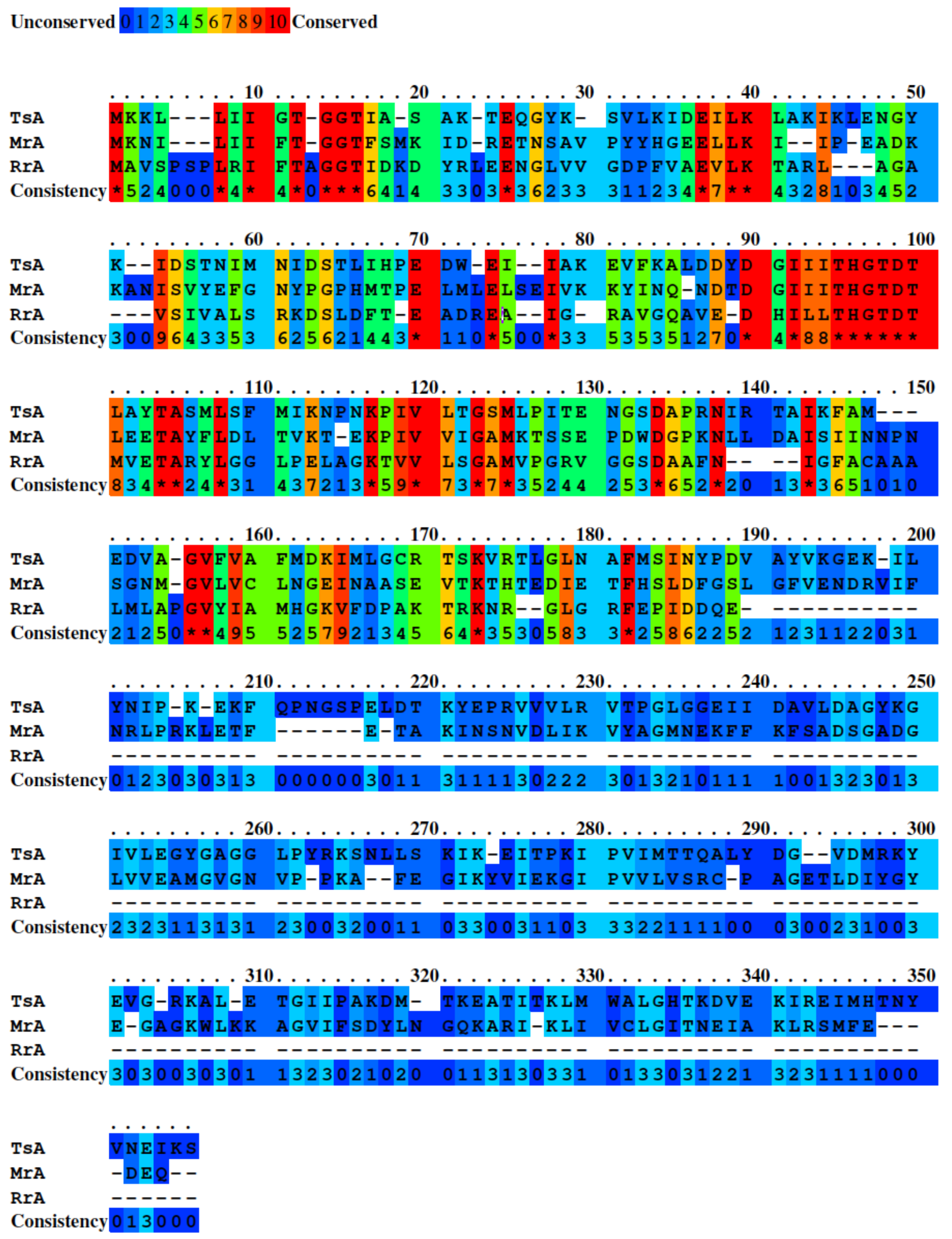
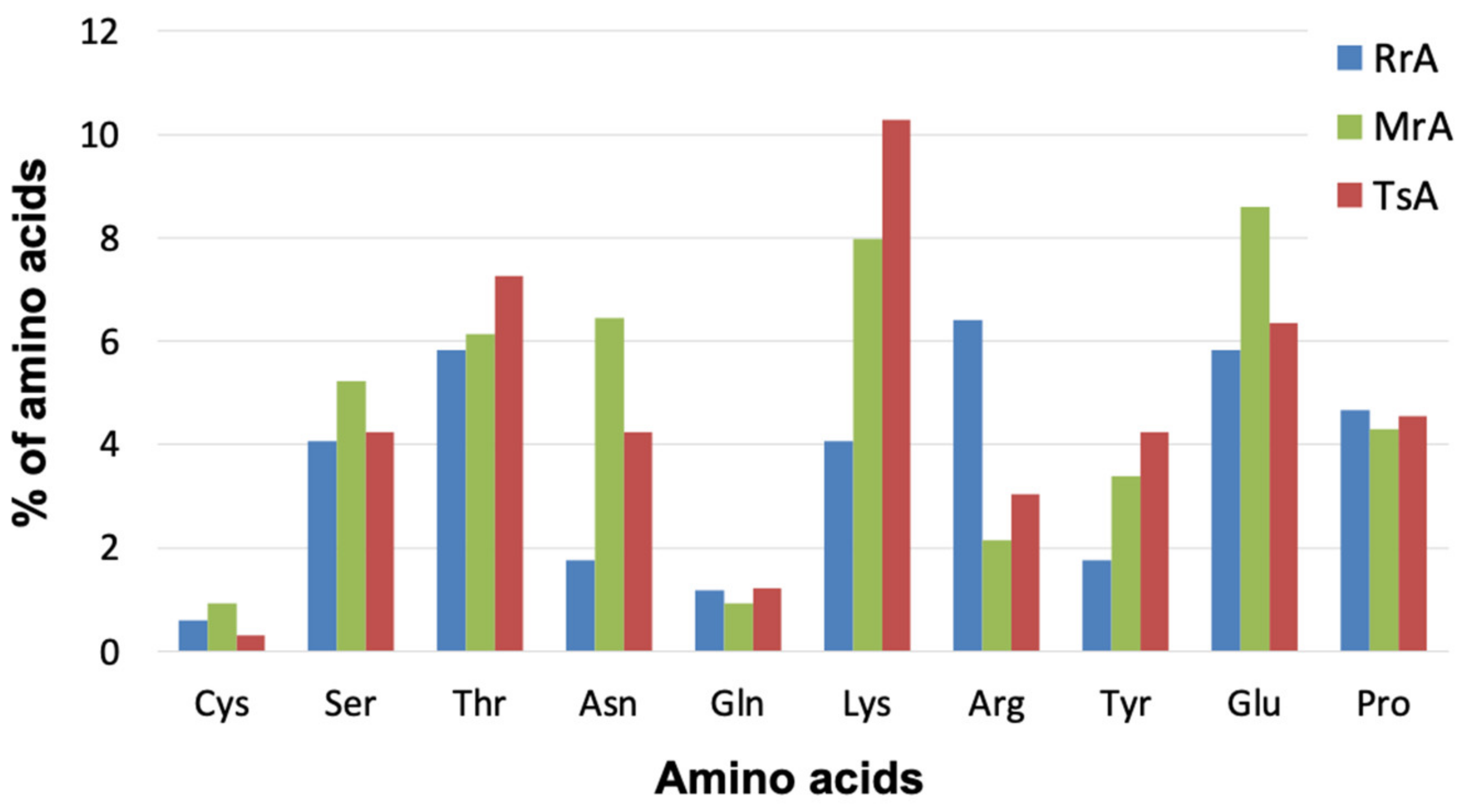
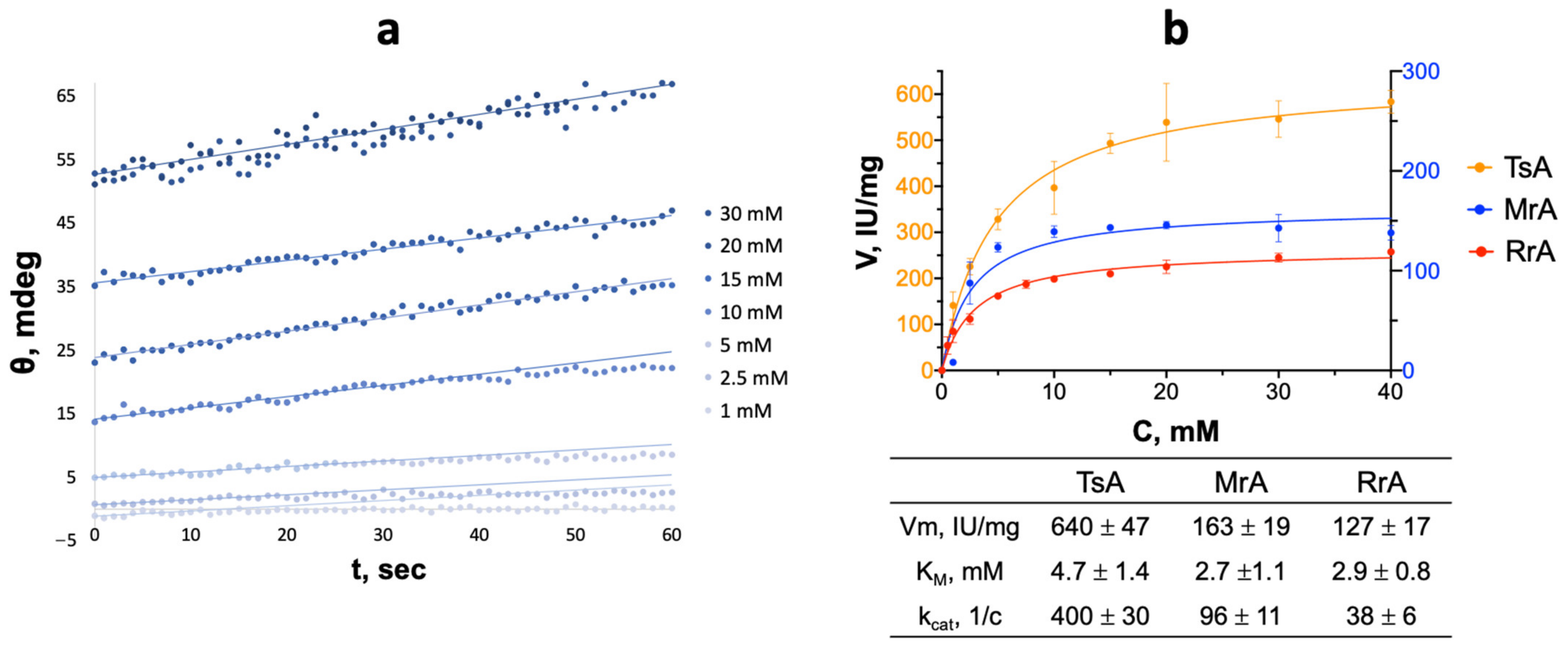

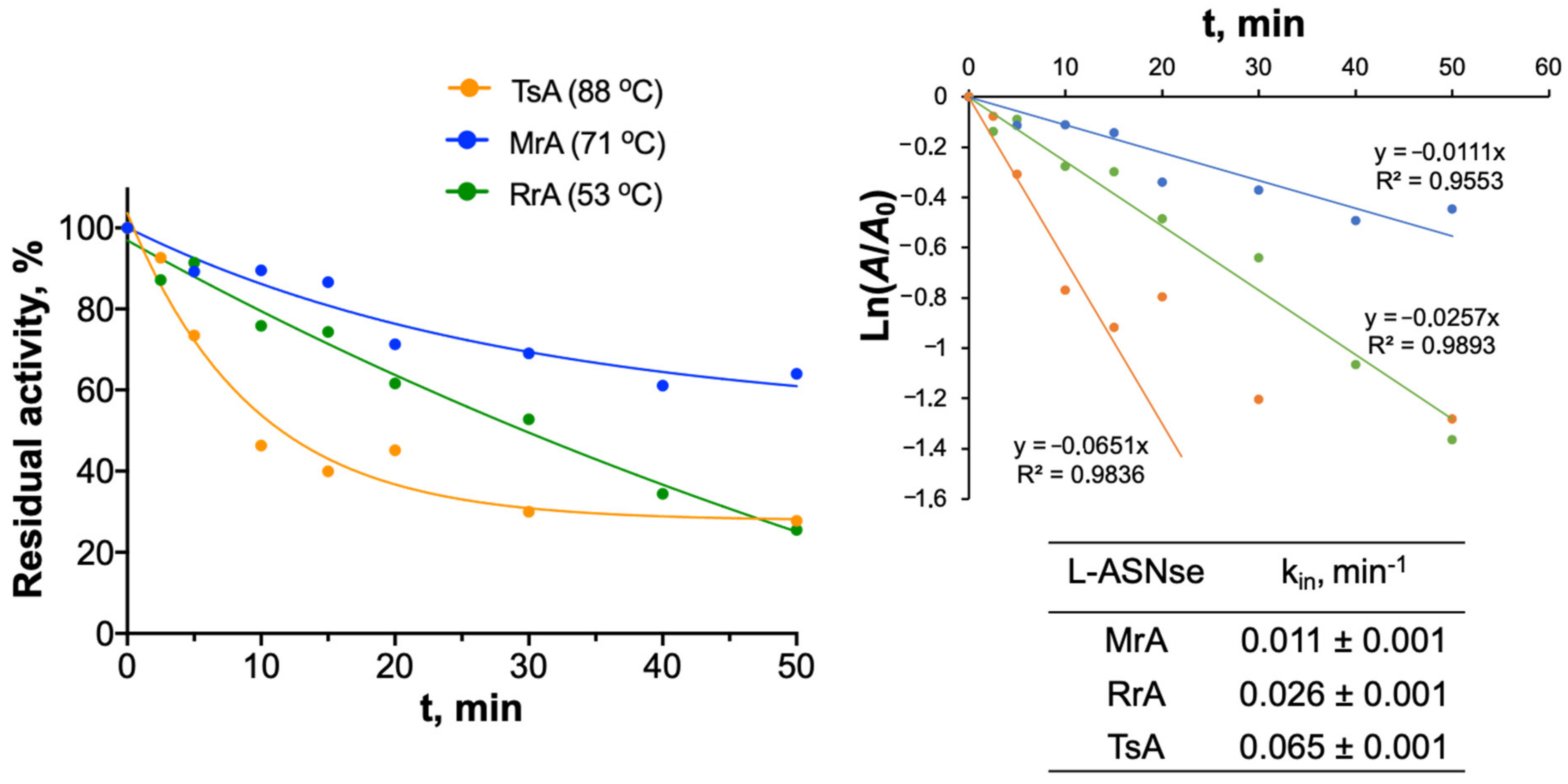
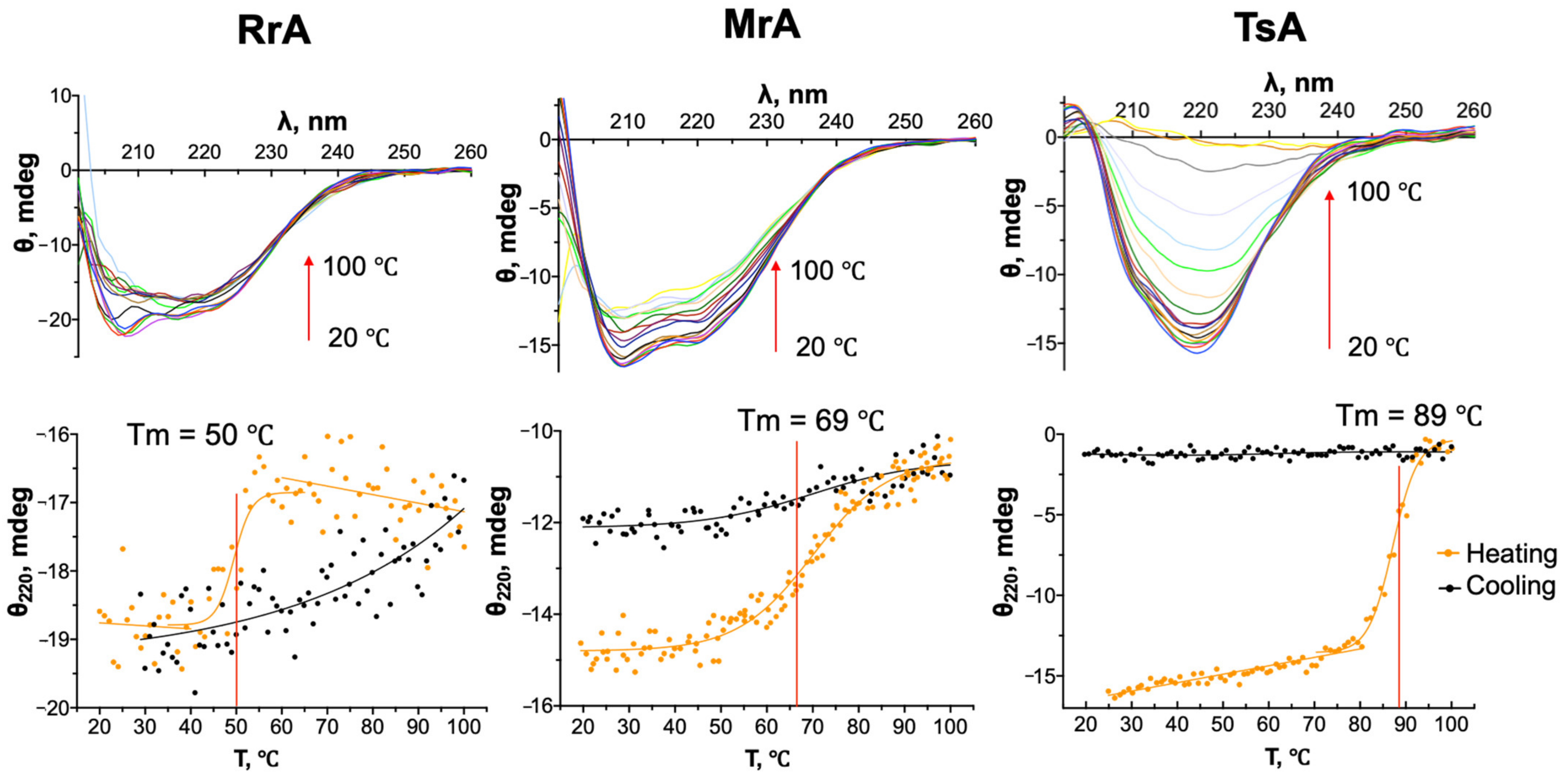

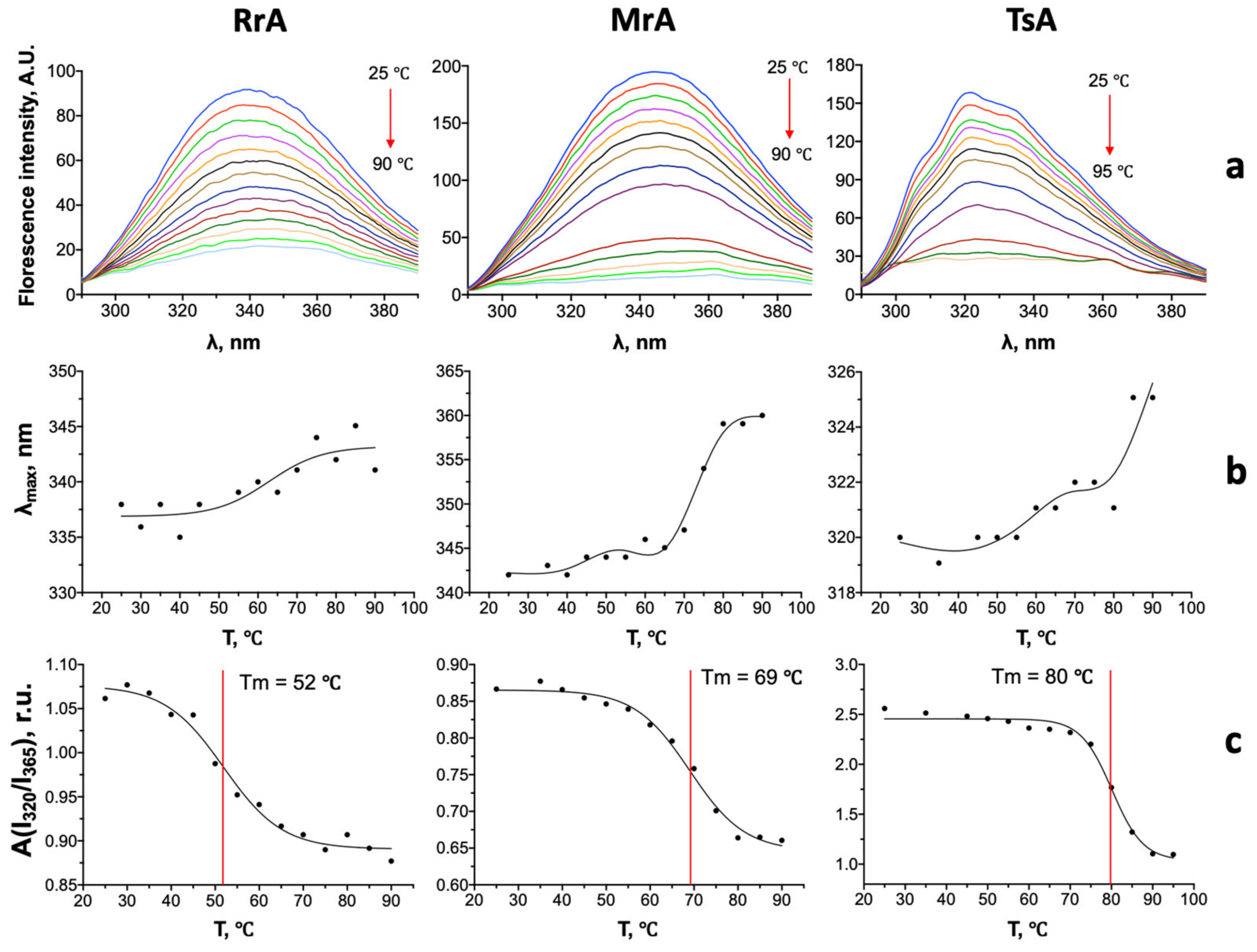
| Parameter | RrA | MrA | TsA |
|---|---|---|---|
| Quaternary structure 1 | tetramer | ND | dimer |
| MW (monomer), kDa | 18 | 35.3 | 37.5 |
| Number of amino acids | 172 | 326 | 331 |
| optimum pH | 9.2 | 9.3 | 9.0 |
| T optimum, °C | 45–50 | 65–70 | 85–90 |
| RrA | MrA | TsA | ||||
|---|---|---|---|---|---|---|
| T, °C | 25 | 100 | 25 | 100 | 25 | 100 |
| α-helix | 33.2 | 28.5 | 33.5 | 30.6 | 35.6 | 8.8 |
| Antiparallel β-sheet | 8.4 | 10.3 | 8.2 | 8.6 | 7.5 | 15.2 |
| Parallel β-sheet | 8.7 | 9.5 | 8.7 | 9.1 | 8.4 | 15.7 |
| β-turn | 16.9 | 17.9 | 16.8 | 17.3 | 16.2 | 17.4 |
| Random coil | 32.2 | 33.4 | 32.6 | 33.3 | 32.2 | 43.2 |
| RrA | MrA | TsA | |
|---|---|---|---|
| ΔG(eff), kJ/mol | 11 ± 2 | 28 ± 4 | 59 ± 6 |
| ΔH(eff), kJ/mol | 148 ± 25 | 237 ± 52 | 346 ± 35 |
| ΔS(eff), kJ/(mol∙K) | 0.5 ± 0.1 | 0.7 ± 0.2 | 0.9 ± 0.1 |
| Tm, °C | 50 ± 1 | 69 ± 1 | 89 ± 1 |
Disclaimer/Publisher’s Note: The statements, opinions and data contained in all publications are solely those of the individual author(s) and contributor(s) and not of MDPI and/or the editor(s). MDPI and/or the editor(s) disclaim responsibility for any injury to people or property resulting from any ideas, methods, instructions or products referred to in the content. |
© 2023 by the authors. Licensee MDPI, Basel, Switzerland. This article is an open access article distributed under the terms and conditions of the Creative Commons Attribution (CC BY) license (https://creativecommons.org/licenses/by/4.0/).
Share and Cite
Dobryakova, N.; Zhdanov, D.; Dumina, M.; Aleksandrova, S.; Pokrovskaya, M.; Genin, A.; Shishparenok, A.; Zhgun, A.; Kudryashova, E.V. Thermal Inactivation Mechanism and Structural Features Providing Enhanced Thermal Stability of Hyperthermophilic Thermococcus sibiricus L-Asparaginase in Comparison with Mesophilic and Thermophilic L-Asparaginases. Catalysts 2023, 13, 832. https://doi.org/10.3390/catal13050832
Dobryakova N, Zhdanov D, Dumina M, Aleksandrova S, Pokrovskaya M, Genin A, Shishparenok A, Zhgun A, Kudryashova EV. Thermal Inactivation Mechanism and Structural Features Providing Enhanced Thermal Stability of Hyperthermophilic Thermococcus sibiricus L-Asparaginase in Comparison with Mesophilic and Thermophilic L-Asparaginases. Catalysts. 2023; 13(5):832. https://doi.org/10.3390/catal13050832
Chicago/Turabian StyleDobryakova, Natalia, Dmitry Zhdanov, Maria Dumina, Svetlana Aleksandrova, Marina Pokrovskaya, Alexander Genin, Anastasia Shishparenok, Alexander Zhgun, and Elena Vadimovna Kudryashova. 2023. "Thermal Inactivation Mechanism and Structural Features Providing Enhanced Thermal Stability of Hyperthermophilic Thermococcus sibiricus L-Asparaginase in Comparison with Mesophilic and Thermophilic L-Asparaginases" Catalysts 13, no. 5: 832. https://doi.org/10.3390/catal13050832
APA StyleDobryakova, N., Zhdanov, D., Dumina, M., Aleksandrova, S., Pokrovskaya, M., Genin, A., Shishparenok, A., Zhgun, A., & Kudryashova, E. V. (2023). Thermal Inactivation Mechanism and Structural Features Providing Enhanced Thermal Stability of Hyperthermophilic Thermococcus sibiricus L-Asparaginase in Comparison with Mesophilic and Thermophilic L-Asparaginases. Catalysts, 13(5), 832. https://doi.org/10.3390/catal13050832








